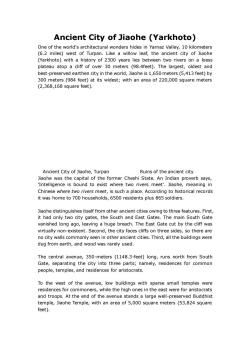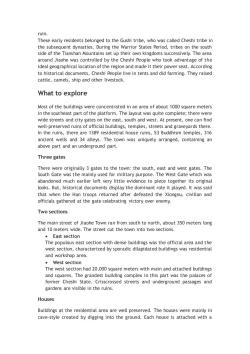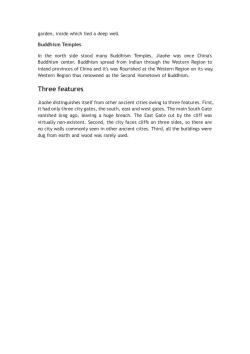《新疆旅游资源》课程教学资源(导游资格考试)英语导游词——交河故城

Ancient City of Jiaohe (Yarkhoto) One of the world's architectural wonders hides in Yarnaz Valley,10 kilometers (6.2 miles)west of Turpan.Like a willow leaf,the ancient city of Jiaohe (Yarkhoto)with a history of 2300 years lies between two rivers on a loess plateau atop a cliff of over 30 meters (98.4feet).The largest,oldest and best-prese ved earthen city in the world,Jiaohe is1,650 meters(5,413 feet)by 300 meters(984 feet)at its widest;with an area of 220,000 square meters (2,368,168 square feet). Ancient City of Jiaohe,Turpan Ruins of the ancient city heas the cit of the former cheshi state.An Indian Intelligence is bound to exist where two rivers s meet' Jiaohe Chinese where two rivers meet,is such a place.According to historical records it was home to 700 households,6500 residents plus 865 soldiers. Jiaohe distinguishes itself from other ancient cities owing to three features.First, it had only two,the South and EastG The m n South Gate vanished long ago,leaving a huge breach.The East Gate cut by the cliff was virtually non-existent.Second,the city faces cliffs on three sides,so there are no city walls commonly seen in other ancient cities.Third,all the buildings were dug from earth,and wood was rarely used. The central avenue,350 -meters (1148.3-feet)long,runs north from South Gate,separating the city into three parts;namely,residences for common people,temples,and residences for aristocrats. To the west of the avenue,low buildings with sparse small temples were residences for nmone while the high ones in the eas t were for ari and troops.At the end of the avenue stands a large well-preserved Buddhist temple,Jiaohe Temple,with an area of 5,000 square meters(53,824 square feet)
Ancient City of Jiaohe (Yarkhoto) One of the world's architectural wonders hides in Yarnaz Valley, 10 kilometers (6.2 miles) west of Turpan. Like a willow leaf, the ancient city of Jiaohe (Yarkhoto) with a history of 2300 years lies between two rivers on a loess plateau atop a cliff of over 30 meters (98.4feet). The largest, oldest and best-preserved earthen city in the world, Jiaohe is 1,650 meters (5,413 feet) by 300 meters (984 feet) at its widest; with an area of 220,000 square meters (2,368,168 square feet). Ancient City of Jiaohe, Turpan Ruins of the ancient city Jiaohe was the capital of the former Cheshi State. An Indian proverb says, 'Intelligence is bound to exist where two rivers meet'. Jiaohe, meaning in Chinese where two rivers meet, is such a place. According to historical records it was home to 700 households, 6500 residents plus 865 soldiers. Jiaohe distinguishes itself from other ancient cities owing to three features. First, it had only two city gates, the South and East Gates. The main South Gate vanished long ago, leaving a huge breach. The East Gate cut by the cliff was virtually non-existent. Second, the city faces cliffs on three sides, so there are no city walls commonly seen in other ancient cities. Third, all the buildings were dug from earth, and wood was rarely used. The central avenue, 350-meters (1148.3-feet) long, runs north from South Gate, separating the city into three parts; namely, residences for common people, temples, and residences for aristocrats. To the west of the avenue, low buildings with sparse small temples were residences for commoners, while the high ones in the east were for aristocrats and troops. At the end of the avenue stands a large well-preserved Buddhist temple, Jiaohe Temple, with an area of 5,000 square meters (53,824 square feet)

Ancient City of Jiaohe.Turpan Pagoda in the Ancient city of Jiaohe The ris we today featred Tang Dyn sty(618-907)archite ctu noou se pue streets,military defense was apparently priority. At the end of the 8 Century,the city was tossed into the reigns of the Turpan, and Mog.Residnts fled fom the destroyed city tinuousl the beginning of the 14 Century,the city was ab d as s was its glory and prosperity of over 2000 years.Miraculously,owing to the arid climate and remote location,the ancient city of Jiaohe remains intact,leaving us a rare exemplar of an earthen castle. Jiaohe Ruins is the best preserved town ruin in China.It is located about 10 kilometers away from Turpan City.The strip-shaped town stretched about 1.650 meters from south to north and the widest point spanned about 300 meters.It is situated on an island between two rivers a the for the area mean the confluence of two rivers."It was initially built about 2,000 years ago and for a long period of time,was controlled by the residents of Gaochang. Jiaohe was completely destroyed by wars in the 14th century.Evidences indicate that the places became ruins as early as the Ming Dynasty.The ruins,very rare in the world, e extremely valuable for studying anci nt cities The history of the Jiaohe Ruins Hejiao's history can trace back to late Stone Age.Ancient residents built their homes in a lagoon island to protect against attack from wild animals and invasions from other tribes.They dug out dwelling caves out from the tough loess and chiseled passages to lead water from the rivers to the town. Visitors can still find some remnants of the simple tools including scraping tools, stone slates and colored pottery ware pieces on the ground close to the town
Ancient City of Jiaohe, Turpan Pagoda in the Ancient City of Jiaohe The relics we see today featured Tang Dynasty ( 618-907) architectural style. Houses were dug downward from the earth, and as no house gates faced the streets, military defense was apparently priority. At the end of the 8 Century, the city was tossed into the reigns of the Turpan, Hui, and Mongols. Residents fled from the destroyed city continuously until in the beginning of the 14 Century, the city was abandoned, as was its glory and prosperity of over 2000 years. Miraculously, owing to the arid climate and remote location, the ancient city of Jiaohe remains intact, leaving us a rare exemplar of an earthen castle. Jiaohe Ruins is the best preserved town ruin in China. It is located about 10 kilometers away from Turpan City. The strip-shaped town stretched about 1,650 meters from south to north and the widest point spanned about 300 meters. It is situated on an island between two rivers and the name for the area means "the confluence of two rivers." It was initially built about 2,000 years ago and for a long period of time, was controlled by the residents of Gaochang. Jiaohe was completely destroyed by wars in the 14th century. Evidences indicate that the places became ruins as early as the Ming Dynasty. The ruins, very rare in the world, are extremely valuable for studying ancient cities. The history of the Jiaohe Ruins Hejiao's history can trace back to late Stone Age. Ancient residents built their homes in a lagoon island to protect against attack from wild animals and invasions from other tribes. They dug out dwelling caves out from the tough loess and chiseled passages to lead water from the rivers to the town. Visitors can still find some remnants of the simple tools including scraping tools, stone slates and colored pottery ware pieces on the ground close to the town

These early residents belonged to the Gushi tribe,who was called Cheshi tribe in the subsequent dynasties.During the Warrior States Period,tribes on the south side of the Tianshan Mountains set up their own kingdoms successively.The area around Jiaohe was controlled by the Cheshi People who took advantage of the ideal geographical location of the region and made it their power seat.According to historical documents,Cheshi People live in tents and did farming.They raised cattle,camels,ship and other livestock What to explore Most of the buildings were concentrated in an area of about 1000 square meters in the southeast part of the platform.The layout was quite complete;there were wide streets and city gates on the east,south and west.At present,one can find well-preserved ruins of official buildings,temples,streets and graveyards there. In the ruins,there are 1389 residential house ruins,53 Buddhism temples,316 ancent wels and 34 alleys. s.The town was uniquely arranged,containing an above part and an underground part. Three gates There were originally 3 gates to the town:the south,east and west gates.The South Gate was the mainly used for military purpose.The West Gate which was that when the Han troops returned after defeated the Xiongnu,civilian and officials gathered at the gate celebrating victory over enemy. Two sections The main street of Jiaohe Town ran from south to north,about 350 meters long and 10 meters wide.The street cut the town into two sections East section The populous east section with dense buildings was the official area and the west section,characterized by sporadic dilapidated buildings was residential and workshop area. West section The west section had 20,000 square meters with main and attached buildings and squares.The grandest building complex in this part was the palaces of former Cheshi State.Crisscrossed streets and underground passages and gardens are visible in the ruins. Houses Buildings at the residential area are well preserved.The houses were mainly in cave-style created by digging into the ground.Each house is attached with a
ruin. These early residents belonged to the Gushi tribe, who was called Cheshi tribe in the subsequent dynasties. During the Warrior States Period, tribes on the south side of the Tianshan Mountains set up their own kingdoms successively. The area around Jiaohe was controlled by the Cheshi People who took advantage of the ideal geographical location of the region and made it their power seat. According to historical documents, Cheshi People live in tents and did farming. They raised cattle, camels, ship and other livestock. What to explore Most of the buildings were concentrated in an area of about 1000 square meters in the southeast part of the platform. The layout was quite complete; there were wide streets and city gates on the east, south and west. At present, one can find well-preserved ruins of official buildings, temples, streets and graveyards there. In the ruins, there are 1389 residential house ruins, 53 Buddhism temples, 316 ancient wells and 34 alleys. The town was uniquely arranged, containing an above part and an underground part. Three gates There were originally 3 gates to the town: the south, east and west gates. The South Gate was the mainly used for military purpose. The West Gate which was abandoned much earlier left very little evidence to piece together its original looks. But, historical documents display the dominant role it played. It was said that when the Han troops returned after defeated the Xiongnu, civilian and officials gathered at the gate celebrating victory over enemy. Two sections The main street of Jiaohe Town ran from south to north, about 350 meters long and 10 meters wide. The street cut the town into two sections. • East section The populous east section with dense buildings was the official area and the west section, characterized by sporadic dilapidated buildings was residential and workshop area. • West section The west section had 20,000 square meters with main and attached buildings and squares. The grandest building complex in this part was the palaces of former Cheshi State. Crisscrossed streets and underground passages and gardens are visible in the ruins. Houses Buildings at the residential area are well preserved. The houses were mainly in cave-style created by digging into the ground. Each house is attached with a

garden,inside which lied a deep well. Buddhism Temples Inthe north side stood many Buddhism Temples. Jiaohe was once China's inland provinces of China and it's was flourished at the Western Region on its way. Western Region thus renowned as the Second Hometown of Buddhism. Three features Jiaohe distinguishes itself from other ancient cities owing to three features.First, it had only three city gates,the south,east and west gates.The main South Gate vanished long ago,leaving a huge breach.The East Gate cut by the cliff was virtually non-existent.Second,the city faces cliffs on three sides,so there are no city walls commonly seen in other ancient cities.Third,all the buildings were dug from earth and wood was rarely used
garden, inside which lied a deep well. Buddhism Temples In the north side stood many Buddhism Temples. Jiaohe was once China's Buddhism center. Buddhism spread from Indian through the Western Region to inland provinces of China and it's was flourished at the Western Region on its way. Western Region thus renowned as the Second Hometown of Buddhism. Three features Jiaohe distinguishes itself from other ancient cities owing to three features. First, it had only three city gates, the south, east and west gates. The main South Gate vanished long ago, leaving a huge breach. The East Gate cut by the cliff was virtually non-existent. Second, the city faces cliffs on three sides, so there are no city walls commonly seen in other ancient cities. Third, all the buildings were dug from earth and wood was rarely used
按次数下载不扣除下载券;
注册用户24小时内重复下载只扣除一次;
顺序:VIP每日次数-->可用次数-->下载券;
- 《新疆旅游资源》课程教学资源(导游资格考试)英语导游词——艾提尕尔清真寺.doc
- 《旅游资源》课程教学资源(导游资格考试)英语导游证考试之导游紧急事件处理.doc
- 《旅游资源》课程教学资源(导游资格考试)英语导游证考试(面试)特殊问题的应变技巧.doc
- 《旅游资源》课程教学资源(导游资格考试)导游英语词汇.doc
- 《新疆旅游资源》课程教学资源(导游资格考试)新疆导游基础知识汇编(共十五章).doc
- 《新疆旅游资源》课程教学资源(导游资格考试)导游基础知识提纲汇总.doc
- 《新疆旅游资源》课程教学资源(导游资格考试)导游资格考试现场知识汇编.doc
- 《新疆旅游资源》课程教学资源(导游资格考试)2013年导游资格现场考试问题.doc
- 《旅游资源》课程教学资源(标准法规)风景名胜区条例.doc
- 《旅游资源》课程教学资源(标准法规)自然保护区条例.doc
- 《旅游资源》课程教学资源(标准法规)环境保护法2014.doc
- 《旅游资源》课程教学资源(标准法规)森林法.doc
- 《旅游资源》课程教学资源(标准法规)旅游法.doc
- 《旅游资源》课程教学资源(标准法规)新疆维吾尔自治区旅游条例.doc
- 《旅游资源》课程教学资源(标准法规)文物保护法实施条例.doc
- 《旅游资源》课程教学资源(标准法规)文物保护法.doc
- 《旅游资源》课程教学资源(标准法规)旅游目的地信息分类与描述.doc
- 《旅游资源》课程教学资源(标准法规)旅游景区讲解服务规范.doc
- 《旅游资源》课程教学资源(标准法规)旅游景区公共信息导向系统设置规范.doc
- 《旅游资源》课程教学资源(标准法规)《旅游资源分类、调查与评价》(GBT18972-2003).doc
- 《新疆旅游资源》课程教学资源(导游资格考试)英语导游词——军垦博物馆.doc
- 《新疆旅游资源》课程教学资源(导游资格考试)英语导游词——喀纳斯.doc
- 《新疆旅游资源》课程教学资源(导游资格考试)英语导游词——坎儿井.doc
- 《新疆旅游资源》课程教学资源(导游资格考试)英语导游词——克孜尔千佛洞.doc
- 《新疆旅游资源》课程教学资源(导游资格考试)英语导游词——葡萄沟.doc
- 《新疆旅游资源》课程教学资源(导游资格考试)英语导游词——葡萄沟.doc
- 《旅游资源》课程教学资源(导游资格考试)导游资格考试面试技巧.doc
- 《新疆旅游资源》课程教学资源(导游资格考试)英语导游词——天池.doc
- 《新疆旅游资源》课程教学资源(导游词和自测试题)旅游资源导游词(共六部分).doc
- 《新疆旅游资源》课程教学资源(导游词和自测试题)旅游资源100道选择题(含参考答案).doc
- 《新疆旅游资源》课程教学资源(导游词和自测试题)选择题100道题(单选和多选,含参考答案).doc
- 《新疆旅游资源》课程教学资源(导游词)交河故城.doc
- 《新疆旅游资源》课程教学资源(导游词)军垦博物馆.doc
- 《新疆旅游资源》课程教学资源(导游词)千佛洞.doc
- 《新疆旅游资源》课程教学资源(导游词)可可托海.doc
- 《新疆旅游资源》课程教学资源(导游词)喀纳斯.doc
- 《新疆旅游资源》课程教学资源(导游词)坎儿井.doc
- 《新疆旅游资源》课程教学资源(导游词)天山天池.doc
- 《新疆旅游资源》课程教学资源(导游词)巴音布鲁克.doc
- 《新疆旅游资源》课程教学资源(导游词)艾提尕尔清真寺.doc
